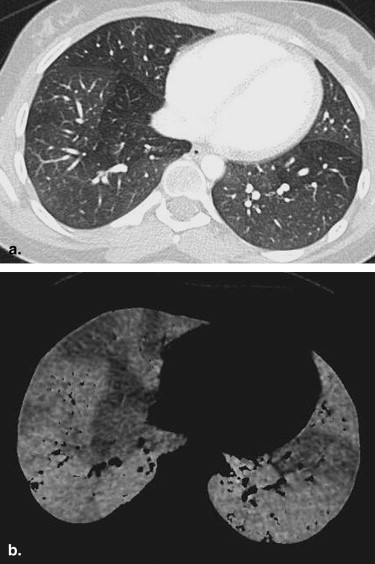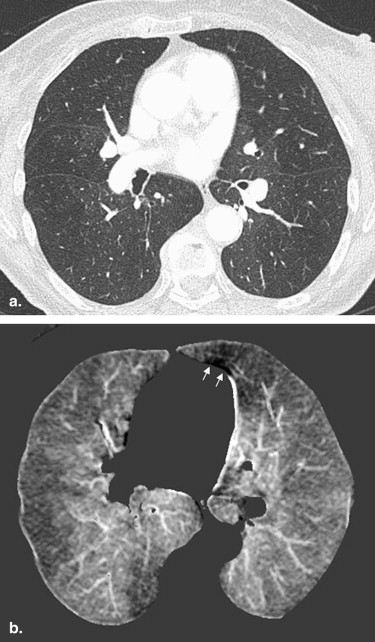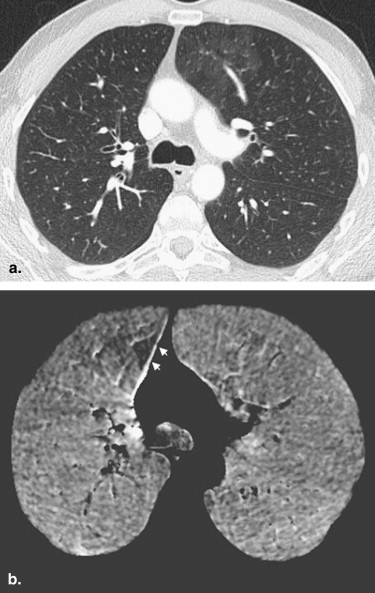Rationale and Objectives
The aim of this study was to evaluate whether the spectral characterization of the iodine content of lung microcirculation could help identify ground-glass opacity (GGO) of vascular origin.
Materials and Methods
Thirty-five consecutive patients with GGO of bronchioloalveolar (group 1; n = 24) and vascular (group 2; n = 11) origin underwent dual-energy multi-detector computed tomographic angiography of the chest using a standard injection protocol. For each patient, two radiologists evaluated by consensus the presence, location, and extent of GGO on diagnostic computed tomographic scans (ie, contiguous 1-mm-thick averaged images from both tubes) and characteristics of the corresponding areas on perfusion scans.
Results
A total of 443 segments with GGO were depicted on the diagnostic scans (group 1, n = 231; group 2, n = 212), always intermingled with areas of normal lung attenuation, with a mean of 12.7 segments with GGO per patient. Areas of GGO were located at the level of the upper lobes ( n = 128), middle lobe and/or lingula ( n = 81), and lower ( n = 234) lobes, involving <25% ( n = 165), 25% to 50% ( n = 103), 50% to 75% ( n = 155), and >75% ( n = 20) of the segmental surface. The overall quality of perfusion scans was rated as interpretable in all patients. Perfusion scans depicted areas of hyperattenuation within segments of GGO with a significantly higher frequency in group 2 (211 of 212 [99.5%]) than in group 1 (27 of 231 [12%]) ( P < .0001). Hyperattenuated areas of vascular origin were observed to match the areas of GGO in surface (203 of 211 [96%]) and contours (208 of 211 [98.6%]).
Conclusion
Dual-energy computed tomography can help recognize GGO of vascular origin.
On computed tomographic (CT) imaging, ground-glass opacity (GGO) is defined as hazy increased opacity of the lung, with preservation of bronchial and vascular margins , which can be observed as a diffuse increase in lung attenuation or as a disseminated abnormality, resulting in areas of variable lung attenuation. This pattern of lung attenuation presents a challenge for radiologists, who must first recognize it and then relate it to the most likely underlying disease. Relying on the visual assessment of lung parenchymal attenuation, this CT pattern is sometimes difficult to depict on high-resolution CT images, especially when of mild severity, which has led to the development of automatic detection and quantification tools .
The second difficulty for radiologists is the nonspecificity of GGO, which has been described in a large variety of disorders, a logical finding when considering that lung attenuation results from the relative proportions of blood, gas, extravascular water, and pulmonary tissue . From a pathophysiologic standpoint, GGO may thus be caused by partial filling or collapse of the airspaces, interstitial thickening, or both, but it may also result from regional or diffuse increase in capillary blood volume. In the latter situation, it is most commonly due to a redistribution of blood flow as a consequence of destructive and/or obstructive changes at the level of the pulmonary circulation, which can be seen in a variety of bronchopulmonary and vascular disorders, such as emphysema, airway diseases, pulmonary arterial hypertension, and pulmonary or venous obstruction . Often described as mosaic perfusion, GGO of hemodynamic origin can be recognized on high-resolution CT images by the presence of increased vascular diameters through the areas of increased lung attenuation, sometimes seen with well-defined borders conforming to the boundaries of secondary pulmonary lobules .
Get Radiology Tree app to read full this article<
Materials and methods
Population
Get Radiology Tree app to read full this article<
Scanning Protocol
Get Radiology Tree app to read full this article<
Reconstructed Scans
Get Radiology Tree app to read full this article<
CT Parameters Analyzed
Get Radiology Tree app to read full this article<
Get Radiology Tree app to read full this article<
Get Radiology Tree app to read full this article<
Conditions of CT Interpretation
Get Radiology Tree app to read full this article<
Statistical Analysis
Get Radiology Tree app to read full this article<
Results
Analysis of Diagnostic Scans
Get Radiology Tree app to read full this article<
Table 1
Characteristics of GGO on Diagnostic Scans in Groups 1 and 2
Group 1: GGO Due to Airspace Disease Group 2: GGO Due to Redistribution of Blood Flow ( n = 231) ( n = 212) Segments with isolated GGO ( n = 389) 226 (98%) 163 (77%) Segments with GGO and dilated vascular sections ( n = 54) 5 (2%) 49 (23%)
GGO, ground-glass opacity.
Get Radiology Tree app to read full this article<
Side-by-Side Analysis of Diagnostic and Perfusion Scans
Get Radiology Tree app to read full this article<
Evaluation of Perfusion Scan Information
Get Radiology Tree app to read full this article<
Table 2
Perfusion Scan Findings in the 54 Segments with GGO and Dilated Vascular Sections on Diagnostic Scans in Groups 1 and 2
Group 1: GGO Due to Airspace Disease Group 2: GGO Due to Redistribution of Blood Flow_P_ ∗ Segments with GGO and increased vascular sections on diagnostic scans ( n = 54) 5 49 <.0001 Degree of attenuation within the 54 segments with GGO and increased vascular sections on diagnostic scans Mild (score 1) 0 10 Moderate (score 2) 0 22 High (score 3) 5 17 Hyperattenuation on the corresponding segments on perfusion scans 0 (0%) 49 (100%) Not applicable
GGO, ground-glass opacity.
Get Radiology Tree app to read full this article<
Table 3
Perfusion Scan Findings in the 389 Segments with Isolated GGO on Diagnostic Scans in Groups 1 and 2
Group 1: GGO Due to Airspace Disease Group 2: GGO Due to Redistribution of Blood Flow_P_ ∗ Segments with isolated GGO on diagnostic scans ( n = 389) 226 163 Degree of attenuation within the 54 segments with GGO and increased vascular sections on diagnostic scans Mild (score 1) 36 90 Moderate (score 2) 43 73 High (score 3) 147 0 Hyperattenuation in the corresponding segments on perfusion scans 27 (11.95%) 162 (99.4%) <.0001
GGO, ground-glass opacity.
Get Radiology Tree app to read full this article<
Get Radiology Tree app to read full this article<
Discussion
Get Radiology Tree app to read full this article<
Get Radiology Tree app to read full this article<
subgroup of GG
Get Radiology Tree app to read full this article<
Conclusion
Get Radiology Tree app to read full this article<
References
1. Hansell D.M., Bankier A.A., MacMahon H., et. al.: Fleischner society: glossary of terms for thoracic imaging. Radiology 2008; 246: pp. 697-722.
2. Heitmann K.R., Kauczor H.U., Mildenberger P., et. al.: Automatic detection of ground glass opacities on lung HRCT using multiple neural networks. Eur Radiol 1997; 7: pp. 1463-1472.
3. Kauczor H.U., Heitmann K., Heussel C.P., et. al.: Automatic detection and quantification of ground glass opacities on high-resolution CT using multiple neural networks: comparison with a density mask. AJR Am J Roentgenol 2000; 175: pp. 1329-1334.
4. Shah R.M., Miller W.: Widespread ground-glass opacity of the lung in consecutive patients undergoing CT: does lobular distribution assist diagnosis?. AJR Am J Roentgenol 2003; 180: pp. 965-968.
5. Miller W.T., Shah R.M.: Isolated diffuse ground-glass opacity in thoracic CT: causes and clinical presentations. AJR Am J Roentgenol 2005; 184: pp. 613-622.
6. Primack S.L., Muller N.L., Mayo J.R., et. al.: Pulmonary parenchymal abnormalities of vascular origin: high-resolution CT findings. Radiographics 1994; 14: pp. 739-746.
7. Remy-Jardin M., Remy J., Giraud F., et. al.: Computed tomography (CT) assessment of ground glass opacity: semiology and significance. J Thorac Imaging 1993; 8: pp. 249-264.
8. Johnson T.R.C., Kraub B., Sedlmair M., et. al.: Material differentiation by dual energy CT: initial experience. Eur Radiol 2007; 17: pp. 1510-1517.
9. Pontana F., Faivre J.B., Remy-Jardin M., et. al.: Lung perfusion with dual-energy multidetector-row CT (MDCT): feasibility for the evaluation of acute pulmonary embolism in 117 consecutive patients. Acad Radiol 2008; 15: pp. 1494-1504.
10. Pansini V., Remy-Jardin M., Faivre J.B., et. al.: Assessment of lobar perfusion in smokers according to the presence and severity of emphysema: preliminary experience with dual-energy CT angiography. Eur Radiol 2008; In press
11. Gorgos A., Remy-Jardin M., Tacelli N., et. al.: Evaluation of peripheral pulmonary arteries at 80 kV and at 140 kV: dual-energy CT assessment in 40 patients. J Comput Assist Tomogr 2008; In press
12. Schwickert H.C., Schweden F., Schild H.H., et. al.: Pulmonary arteries and lung parenchyma in chronic pulmonary embolism: preoperative and postoperative CT findings. Radiology 1994; 91: pp. 351-357.
13. Bergin C.J., Rios G., King M.A., et. al.: Accuracy of high-resolution CT in identifying chronic pulmonary thromboembolic disease. AJR Am J Roentgenol 1996; 166: pp. 1371-1377.
14. Martin K.W., Sagel S.S., Siegel B.A.: Mosaic oligemia simulating pulmonary infiltrates on CT. AJR Am J Roentgenol 1986; 147: pp. 670-673.
15. King M.A., Bergin C.J., Yeung D.W., et. al.: Chronic pulmonary thromboembolism: detection of regional hypoperfusion with CT. Radiology 1994; 191: pp. 359-363.
16. Remy-Jardin M., Wattinne L., Remy J.: Transcatheter occlusion of pulmonary arterial circulation and collateral supply: failures, incidents and complications. Radiology 1991; 180: pp. 699-705.
17. Eber C.D., Stark P., Bertozzi P.: Bronchiolitis obliterans on high-resolution CT: a pattern of mosaic oligemia. J Comput Assist Tomogr 1993; 17: pp. 853-856.
18. Sherrick A.D., Swensen S.J., Hartman T.E.: Mosaic pattern of lung attenuation on CT scans: frequency among patients with pulmonary hypertension of different causes. AJR Am J Roentgenol 1997; 169: pp. 79-82.
19. Worthy S.A., Muller N.L., Hartman T.E., et. al.: Mosaic attenuation pattern on thin-section CT scans of the lungs: differentiation among infiltrative lung, airway and vascular diseases as a cause. Radiology 1997; 205: pp. 465-470.
20. Tunariu N., Gibbs S.J.R., Win Z., et. al.: Ventilation-perfusion scintigraphy is more sensitive than multidetector CTPA in detecting chronic thromboembolic pulmonary disease as a treatable cause of pulmonary hypertension. J Nucl Med 2007; 48: pp. 680-684.
21. Groell R., Peichel K.H., Ugowitzer M.M., et. al.: Computed tomography densitometry of the lung: a method to assess perfusion defects in acute pulmonary embolism. Eur J Radiol 1999; 32: pp. 192-196.
22. Coche E., Verschuren F., Hainaut P., et. al.: Pulmonary embolism findings on chest radiographs and multiple spiral CT. Eur Radiol 2004; 14: pp. 1241-1248.
23. Matsuoka S., Kurihara Y., Yagihashi K., et. al.: Quantification of thin-section CT lung attenuation in acute pulmonary embolism: correlations with arterial blood gas levels and CT angiography. AJR Am J Roentgenol 2006; 186: pp. 1272-1279.
24. Suga K., Kawakami Y., Iwanaga H., et. al.: Comprehensive assessment of lung CT attenuation alteration at perfusion defects of acute pulmonary thromboembolism with breath-hold SPECT-CT fusion images. J Comput Assist Tomogr 2006; 30: pp. 83-91.
25. Thoma P., Rondelet B., Mélot C., et. al.: Acute pulmonary embolism: relationships between ground-glass opacification at thin-section CT and hemodynamics in pigs. Radiology 2009; 250: pp. 721-729.
26. Hansell D.M., Wells A.U., Rubens M.B., et. al.: Bronchiectasis: functional significance of areas of decreased attenuation at expiratory CT. Radiology 1994; 193: pp. 369-374.
27. Arakawa H., Stern E.J., Nakamoto T., et. al.: Chronic pulmonary thromboembolism: air trapping on computed tomography and correlation with pulmonary function tests. J Comput Assist Tomogr 2003; 27: pp. 735-742.
28. Arakawa H., Webb W.R., McCowin M., et. al.: Inhomogeneous lung attenuation at thin-section CT: diagnostic value of expiratory scans. Radiology 1998; 206: pp. 89-94.
29. Stern E.J., Muller N.L., Swensen S.J., et. al.: CT mosaic pattern of lung attenuation: etiologies and terminology. J Thorac Imaging 1995; 10: pp. 294-297.
30. Stern E.J., Swensen S.J., Hartman T.E., et. al.: CT mosaic pattern of lung attenuation: distinguishing different causes. AJR Am J Roentgenol 1995; 165: pp. 813-816.


